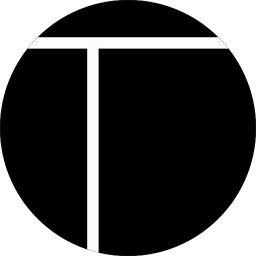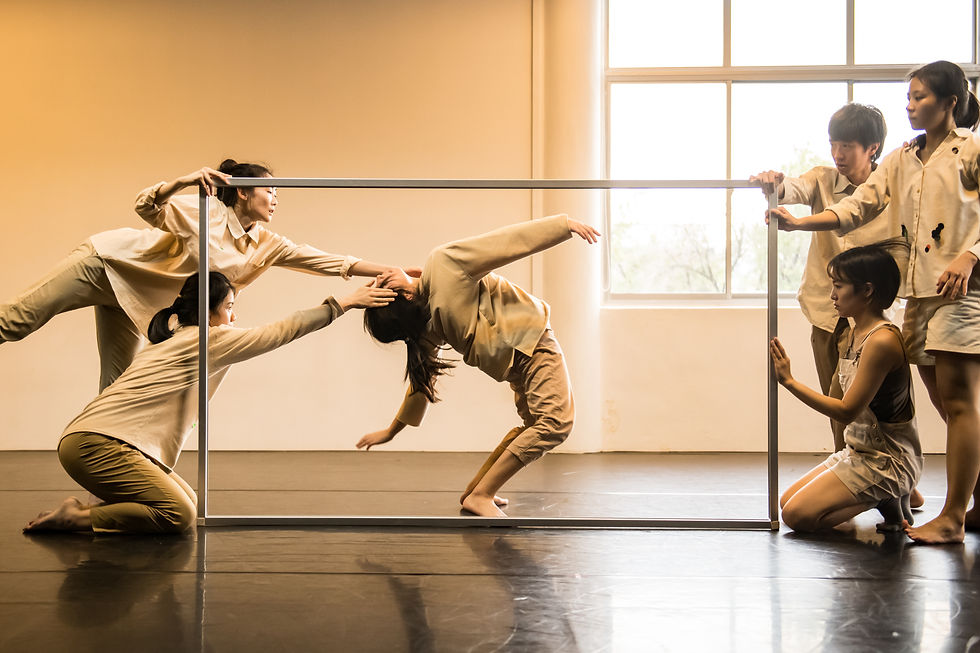A Review: Dancers' Locker 2023
- Tarinao

- May 6, 2023
- 8 min read
Updated: May 8, 2023
Experimental works are often full of surprises. Sometimes it resonates deeply, sometimes it just does not, and that’s totally fine. As an audience, you have already agreed to the terms and conditions of experimental works, which is to be surprised in more ways than one. The triple bill—Dancers’ Locker 2023, also the final rendition by artists at Frontier Danceland was no exception. Since its inception Dancers' Locker, was intended to be a platform that allows company artists to explore their artistic personality and identity as dancemakers with mentorship from the artistic director and co-founder, Low Mei Yoke, this year, set in the company's home studio space at Goodman Arts Centre.
Kirby Dunnzell’s IYKYK [If You Know You Know] opened the show. As a debutant choreographer with the company, Dunnzell worked in collaboration with his dancers, Sammantha Yue and Mark Robles. Dunnzell was literal in the expression and presentation of his worldview both through the digital and movement realm for this piece. The work revolved around living with a digital self and a physical self that often overlap. It started with Robles carrying a smartphone moving through space in his dancer-like groove. His screen time activity was totally transparent and publicly projected onto a sheer white veil hung at the right upstage corner of the studio. Intentional or not, the piece was straightforward without the need for much deciphering as Robles was taking selfies and scrolling through Instagram, enjoying his partner, Yue’s handle, an activity highly relatable for almost all millennials and Gen Z as a common pastime activity. It was all too easy to know what to focus on—the screen.
Dunnzell had chosen a style of presentation that is similar to the movie “Searching” released in 2018 directed by Aneesh Chaganty, starring John Cho who appeared on screen through the camera of a laptop in the movie’s entirety. Though it was very easy to forget that this was a live performance and started focusing solely on the screen, Dunnzell very smartly created moments in his piece to capture the attention of his audience by turning the all-too-attractive projector screen on and off. More than that, the use of the full-ceiling-height sheer projector screen which slitted open in the middle allowed dancers to enter and exit the “digital corner” seamlessly. This had the effect of forcing the audience to come back to the physical reality very quickly. Robles and Yue were dancing on screen and off in solos and duets, at times in separate spaces at times in the same space whether digital or physical while being supported by the accidental digital lighting of the projector. Robles masterfully partnered with Yue in their duet. It was a treat to watch both of them moving together in the physical space of the studio where their movement was not limited. Risking gimmick, Dunnzell included an interactive section by having Yue, hidden in the “digital corner” partially seen starting her Instagram live session which the audience can join passively or actively by commenting or sending some emojis that can be seen on screen in real-time both virtually and physically. The piece was mind-bogglingly futuristic and entertaining for the contemporary audience whose attention span had grown shorter, at the same time, marketing the three-day performance to prospective audiences who may decide that making a trip to the live performance space could be worth their time after all. It was a youthful piece that is always highly welcome in experimental production.
The centrepiece of the triple bill was a solo choreographed and performed by Tan Xin Yen. The piece was aptly named, Pink Underwear composing three exclusively pink props which were a child-size pink sofa, a pink 3D blanket made up of claw machine soft toys that were sure eye-catchers in the all-black studio, and the less eye-catching wireless microphone lit in pink; with Yen, a moving body in complete contrast, dressed-down in nude, almost a birthday suit, baring only her powerful stage presence narrated her journey as a dance artist going beyond contemporary dance into dance theatre for this piece. The beginning of the solo was introduced via recorded voice spoken in true Penangite Hokkien about her signature ear-to-ear smile since young which she obviously still possessed today. The recording played in Yen's voice, “…Today, I’m still smiling and laughing like I used to. But are those expressions real?” And her infectious smile that she started off exhibiting to the audience seated on the floor in close proximity to her in the studio gradually turned forceful and imposing, in a way that looked uncomfortable even to those seated further away.
The piece seemed intentionally personal as this was Yen’s Swansong work with the company. The piece could be seen from the perspective of a dance artist's way of writing her own biography into a 20-minute-long live performance. The beauty of Frontier Danceland's effort to create a platform for its artists to develop their unique artistry can be witnessed through Yen's successful invitation to her audience into her world of pink which evidently meant something to her. Her movement suggested growth from being a child to a curious teenager exploring her pubescent body, and later an adult who was still just a child inside, keen to explore the endless possibilities of different selves in a world of “pink” that was the only thing that did not change. She took a seat on the tiny pink sofa moving in a child-like manner in all directions except the right side up to finally draping the over-the-top pink 3D blanket on her shoulders spinning away in her own fantasy, it was a kind of freedom that seemed private to her which can only be keenly felt. Pink was what pulled the piece together as if “pink” is at the core of her being, when words were being used instead of music, it was coming from a pinkly lit microphone stationed at the left downstage corner that symbolized the narration of entire being in life to this moment in time. It was almost like the short ballet “Le Spectre de La Rose”, with the use of a chair and instead of a rose, a very geographical and cultural symbol of claw-machine soft toys sewn into a massive round blanket both of which she left behind while she "grande exit" into the darkness at the end of the piece as if into her unknown yet eventful future. The piece could have achieved an even more dramatic effect and grandeur of a biographical solo for Yen to be dressed or even painted in all pink.
The triple bill closes with a piece created by Sammantha Yue in collaboration with all three other company artists, Robles, Yen, and Dunnzell. The curtains to the doors of the studios were revealed and the three dancers started running in and out of the doors impromptu. Lights from the streets outside the studio were gently seeping through the transparent one-way door. The three dancers were interacting with the audience, entertaining them with comical gestures as if playing hide-and-seek. It was a fun section and perhaps could have been further optimized for audience engagement to have an en-face view to the door to reduce the need to keep one's head turned sideways for the entire section in an attempt to keep track of what the cheeky dancers were up to. The section was brought to a stop by the unrolling of the light grey dance mat that stretched as long as the entire diagonal of the studio space. Yue has a way of creating memorable visuals with this piece. The dance mat was used to represent a path that later was sculpted into an impressive abstract structure placed almost centrally in space.
Yue provided a two-line text to the audience to summarise her work Labyrinth. It was key to be able to follow the piece and it said:
An antechamber, a door left ajar A single space carved out, allows one in
The doors seemed to represent different possibilities and opportunities, the only one that was left open led to a path into a space that was moulded and symbolized by the dance mat, long and enfolding. The fundamental idea based on the synopsis of this rather abstract piece was full of potential for further development into something quite poetic. Perhaps due to the lack of assistance from the studio's limited lighting while also being the third piece of the program after two very strong conceptual and narrative works, which were straightforward and easy to relate to (one being social media heavy, and one being biographical in nature). In comparison, Yue’s piece, eloquently choreographed and well performed by all three dancers moving in organic congruence along the diagonally aligned path made up of the dance mat was a very pleasant sight but lacked cohesiveness between the two very strong ideas. The piece seemed to be missing a link between the "door" section to the "dance mat" section. A small linkage that might help guide the audience to fall in love with the beauty of abstraction, which was what Yue seemed to lean towards with Labyrinth.
The triple bill was overall engaging while allowing the audience of the company to witness the development of artists from the role of a performer to that of a creator. While the performance succeeded in showcasing the exploration of the many aspects of the self through the artists' diverse experiences, it could have brought on a stronger dynamic to connect all stakeholders onstage and off by moving away from self-centrism into audience-centrism. To be able to focus beyond self-expression into the art of transporting the audience into the world of imagination. Arts play this role of looking beyond ourselves into the environment, to connect others to the self through shared ideals, thoughts, beliefs, and raw emotions. Audience-centrism is to be mindful of the audience's experience, and how an artwork can be presented in a way that has the most impact on the audience without losing the artists' original intention and or selves. Dancers' Locker 2023 intrigued the question: would performances similar in their experimental nature succeed in attracting more diverse communities to bask in the world of dance and movement by introducing the audience-centric approach and in turn enrich artists involved to go a little deeper in the process of creation, aiming to create not just movement, but meaning to all parties?
About Dancers’ Locker:
Past editions of Dancers’ Locker served as a creative platform for Frontier Danceland’s company artists to explore choreography of a live performance, working towards the presentation of short works in intimate settings of Frontier Danceland studio at Stamford Arts Centre, Goodman Arts Centre and Singapore Chinese Cultural Centre Roof Garden. The 2020 edition saw the experimentation of performance and choreography through the audio-visual medium of film as mediated through the screen.
About Frontier Danceland:
Founded in 1991 by Low Mei Yoke and Tan Chong Poh, Frontier Danceland is a non-profit professional contemporary dance company in Singapore that became full-fledged in 2011. Committed to cultivating versatility in expression through the body, Frontier Danceland’s dynamic range of innovative works craft unique experiences that heighten sensibilities and evoke introspection.
Frontier Danceland has worked with both local and international dance-makers including Noa Zuk, Ohad Fishof and Shahar Binyamini (Israel), Richard Chappell and Deborah Nightingale née Galloway (United Kingdom), Stephanie Lake and Luke Smiles (Australia), Edouard Hue and Thomas Lebrun (France), Sita Ostheimer (Germany), Sascia Pellegrini (Italy), Matej Kejzar (Belgium/Slovenia), Liu Yen-Cheng and Tung I-Fen (Taiwan), and Victor Ma Choi-Wo (Hong Kong).
Throughout the years, Frontier Danceland has represented Singapore internationally, including three sold-out shows at Batsheva Dance Company in Tel Aviv (Israel), Kuandu Arts Festival (Taiwan), 25th and 30th Quinzena De Dançe De Almada – International Dance Festival (Portugal), Festival Tour d’Horizons (France) and Dance in the City (Belgium/Germany).
















Comments